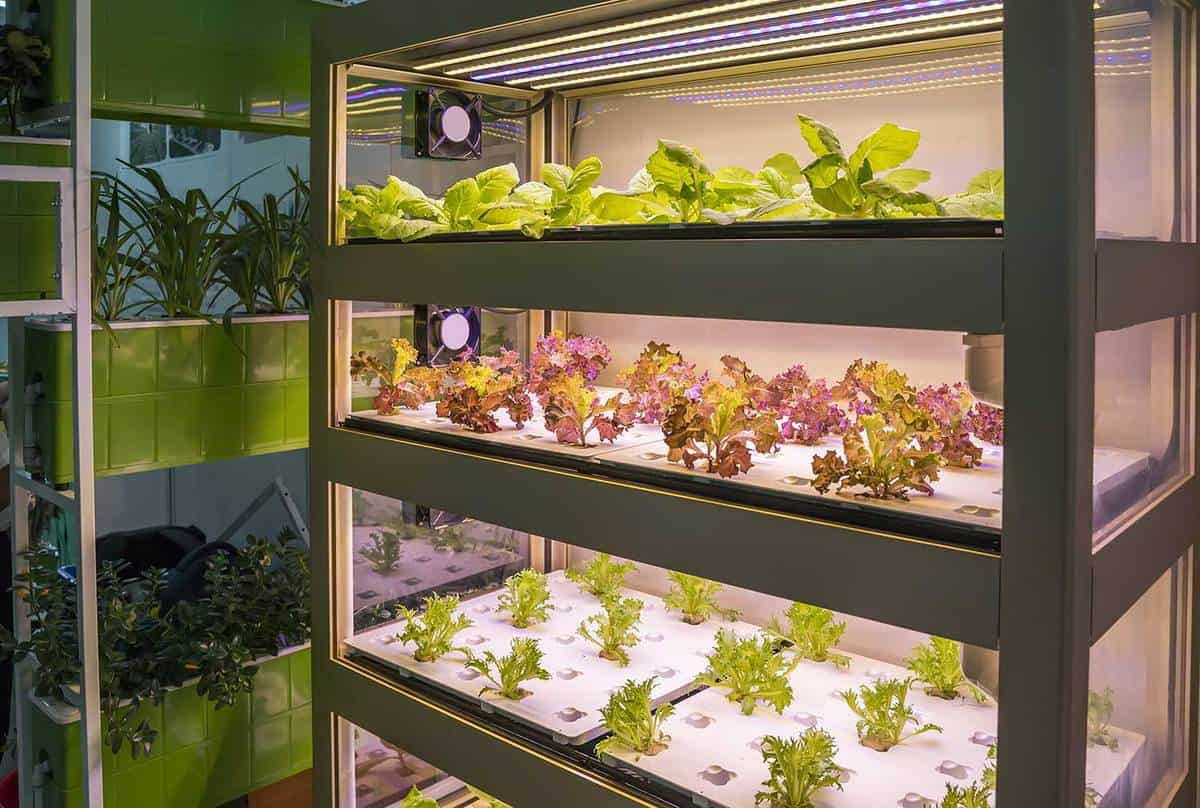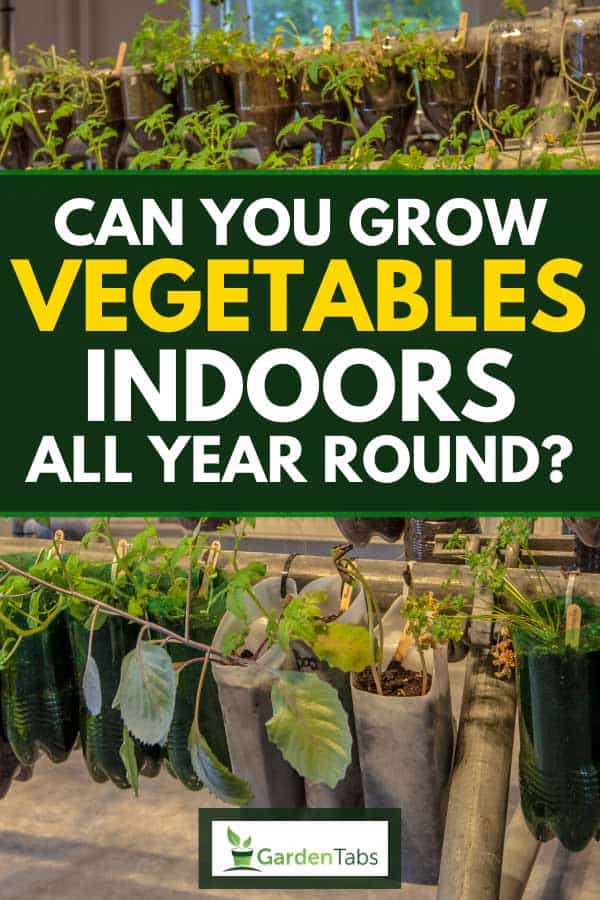Whether you tend to a flourishing outdoor container garden or nurture plants nestled in the earth, the fruits of your labor ignite a deep sense of pride and sheer delight.
As the weather turns brisk and the days get shorter, the gardening season starts to end. But does a growing season have to end? Can you grow vegetables indoors and all year round?
Yes, vegetables can be grown indoors all year round. Most edible plants you can grow outside will thrive in the right conditions inside.
Most vegetables are grown indoors in some fashion, often in a greenhouse. But most of us don't have a greenhouse, so how do we successfully grow our vegetables indoors?
There are a few tips to follow to ensure a healthy garden. Just keep reading, and we'll answer some additional questions you might have about growing vegetables indoors.
The Right Amount Of Light
The number one thing your indoor vegetable plants need to blossom is light. It sounds simple enough, but as the seasons change, natural light levels diminish.
Winter days are short, and even that sunniest corner of your home won’t get as much light as during other seasons. Remember, your vegetable plants are sun-lovers; at least 6 hours of direct sunlight daily, sometimes even more!
You might've heard that many big vegetable growers use greenhouses to tackle this problem. But let's be honest – not all gardeners have the space or budget for one.
The Game-Changer? Grow Lights.
These handy devices can be your indoor garden's sunshine, ensuring your veggies get all the light they need anytime.
Choosing the size or type of grow lights depends on your space and how many plants need light. For a smaller space, you can hang a total spectrum 25W LED grow light with a panel size of 9.9 x 4.68 inches.
If you don't have space to hang lights or need a more mobile solution, use a self-standing 60W grow light with adjustable arms.

Click here to buy this on Amazon.
Click here to buy this on Amazon.
You can also read these posts:
Grow Lights for Your Vertical Garden: A Complete Guide.
Can Any Vegetables Be Grown Indoors?
Just about any vegetable can be grown indoors. Available space will likely be the most significant factor in what you can grow indoors.
Remember that some plants, like carrots, need deep soil containers while others, like butternut squash, have vines that need to spread wide.
Here is a list of popular vegetables that can be grown indoors year-round.
Tomatoes
Tomatoes should be started inside from seeds at the end of summer. You can undoubtedly begin to sow seeds any time of the year, but tomatoes peak outdoors in the summer. Extend the growing season indoors and plant seeds in September.
Carrots
Carrots grown outside are best when harvested in the fall or spring. To keep carrots growing year-round, plant them inside as winter begins or spring ends.
Plant your seeds biweekly to have carrots flourishing throughout the year. And lastly, choose a variety that doesn't have a deep root system for best results.
Kale
Kale likes chilly weather. This cold-hardy vegetable is planted outdoors in spring and fall. To grow your own indoors, plant seeds at the beginning of summer.
Cauliflower
Cauliflower is another cool-weather crop. It grows outdoors in the chillier months of spring and fall. Start planting your seeds toward the end of spring.
Cabbage
Cabbage grows in the fall and spring. With its long growing season, it's accustomed to various temperatures. Start planting your seeds indoors mid-fall.
Radishes
Radishes have shallow root systems and will grow well indoors. This plant prefers cold weather, so planting seeds in spring or early autumn is ideal.
What Vegetables Can I Grow Inside During The Winter?

You can grow any vegetable that you want indoors in any season. As the winter sets in, the days are shorter, and light isn't as abundant. To help your vegetable plants flourish indoors, especially in the winter, you must ensure enough light.
Below is a list of vegetables that are simple enough to grow.
Green Onions
The easiest way to grow green onions is with leftover green onion roots. Submerge the roots in a container of water. Change the water weekly. Once the shoots reach five inches, the onions can be moved to a pot of soil.
Beets
To expedite germination, soak beet seeds overnight. Place your soaked seeds in a container at least 16 inches deep that drains well. Cover the seeds with a thin layer of soil.
Broccoli
Sow seeds one-half inch deep in a planter of soil. Once seeds mature, and after the first harvest, broccoli will send up shoots for weeks.
Spinach
Spinach seeds should be sown ½ an inch deep into a seed tray of soil. Direct sunlight isn't necessary to grow spinach. However, you still may need to use your grow lights in the winter.
Squash
A bush type of squash like a summer squash, can be grown indoors and takes up less space than those that grow on vines. Sow five seeds in the center of a container filled with soil and cover them with a 1/2 inch of the potting mix.
Lettuce
Fill small planting containers or flats with about 4 inches of planting mix. Scatter, then cover your seeds with the mix, keeping them about an inch apart. You can start harvesting baby lettuces in as little as three weeks.
Celery
Regrow celery from its base. Cut the bottom from the celery stalks and place it in a shallow water container. After a week or so, you'll see regrowth. Move the celery to an indoor box filled with soil and watch it grow.
Peppers
You can buy or use seeds from a pepper you've grown to start a new plant. Pepper plants in portable containers can be moved from the outside to the inside to continue growing.
Potatoes
Take a sprouted potato, cut it into a two-inch piece, and plant it in a container of soil that has a 2.5-gallon capacity.
Get Your Indoor Garden Growing
Growing vegetables indoors is not complicated. You might dream of a large outdoor garden overflowing with lettuce and tomatoes. But when winter rolls around, most of us will lose our gardens to cold, dark days.
You can and should create your vegetable garden inside. With some planning, proper care, and tons of grow lights, you can harvest fresh vegetables year-round from your indoor plants. Happy planting!


